#visit brunei
Text
#PM Modi in Brunei#Modi arrives in Brunei#PM Modi Brunei visit#PM Modi Brunei Singapore visit#India Brunei Ties#Brunei#Brunei Singapore#PM Modi Brunei#PM Modi Two-Nation visit#India-ASEAN relations
1 note
·
View note
Text
भारत की पहली यात्रा पर आएंगे संयुक्त अरब अमीरात के क्राउन प्रिंस, पीएम मोदी ने दिया था निमंत्रण
भारत की पहली यात्रा पर आएंगे संयुक्त अरब अमीरात के क्राउन प्रिंस, पीएम मोदी ने दिया था निमंत्रण
#news #viral #trending #update #newspaper #breakingnews #currentaffairs #dailynews #newsletter #newspapers #newsupdate #People #Media #info #Journalism #Press
Delhi News: संयुक्त अरब अमीरात के क्राउन प्रिंस शेख खालिद बिन मोहम्मद बिन जायद अल नाहयान अगले हफ्ते भारत की 2 दिवसीय यात्रा पर आने वाले हैं। कुछ महीने पहले उन्हें प्रधानमंत्री नरेंद्र मोदी ने भारत आने का निमंत्रण दिया था।
अबू धाबी के क्राउन प्रिंस शेख खालिद बिन मोहम्मद बिन जायद अल नाहयान ने पीएम मोदी के निमंत्रण को स्वीकार कर लिया है। अब वह आगामी 9-10 सितंबर को भारत की आधिकारिक यात्रा…
#abu dhabi crown#abu dhabi crown prince#abudhabi crown prince#Crown Prince#crown prince al nahyan of abu dhabi#crown prince of abu dhabi#crown prince of abu dhabi net worth#crown prince of abu dhabi sheikh mohamed bin zayed al nahyan#crown prince of dubai#Crown Prince of UAE#crownprince#first visit to India#meex china abu dhabi prince#melodi meme#Modi#modi 3#modi 3.0#modi in brunei#modi in gulf#modi in kyiv#modi in poland#modi ka bhashan#modi live#modi live news#modi live today#modi news#modi news live#modi news today#modi samachar#modi shorts
0 notes
Text
PM Brunei Visit : ब्रुनेई की राजधानी से चेन्नई के लिए सीधी विमान सेवा होगी शुरू
PM Brunei Visit : ब्रुनेई की राजधानी बांदर सेरी बेगावान और भारत के चेन्नई के बीच सीधी विमान सेवा शुरू होगी। यह एलान प्रधानमंत्री नरेंद्र की ब्रुनेई यात्रा के दौरान की गई है। सीधी विमान सेवा के अलावा दोनों देशों ने रक्षा, अंतरिक्ष और लोगों के लोगों के बीच संबंध के क्षेत्र में भी अपसी सहयोग बढ़ाने पर सहमति जताई है।
Rahul Gandhi Election Rally : राहुल गांधी ने चुनाव के लिए लॉन्च की चार्जशीट
दोनों…
0 notes
Text

FOODS OF BRUNEI: FAMOUS DISHES OF BRUNEI
1 note
·
View note
Text
Very good meeting between PM Anwar Ibrahim and Brunei King
Very good meeting between PM Anwar Ibrahim and Brunei King

View On WordPress
0 notes
Note
Weekly update:

No new places this week.
The only new thing is that I added a global count to the statistics: we are at 86% of all world countries visited.
List of countries
Thanks for the stats! For those wondering, we're missing:
The republic of congo, equatorial guinea, eritrea, guinea-bissau, malawai, somalia, south sudan, zambia, bahamas, barbados, grenada, haiti, Jamaica, Nicaragua, saint kitts and nevis, saint Vincent and the grenadines, afghanistan, bangladesh, brunei, iraq, israel, kuwait, qatar, syria, timor-leste, san marino, marshall islands, nauru, and samoa.
Please submit places from these countries if you know of any good ones!
36 notes
·
View notes
Text
untuk hari bahasa ini, saya cubalah mengajarkan semua tentang sikit budaya melayu dan berkongsi kosa kata juga (ENG TRANSLATION)
(for this language day, I will try to teach a little about Malay culture and share vocabulary as well)
i made the original post detailing some fun stuff abt my culture of being malay (specifically from perspective living as a Malay from Singapore), i want to do an english translation so its more accessible to those who don't speak malay. This isnt an exact translation (plus im adding mroe additonal info) so keep that inmind
FIRST, what is the Malay language? This is an Austronesian language, also the national language in Brunei, Malaysia and Singapore. Malay is usually written in Latin script, also known as Rumi. There is also Jawi script based on Arabic writing. If you want to know (most) letters in Jawi, this is a video stuck in my head from Andalus (I'm bad at writing in Jawi and Arabic too, even though I study, I don't know much;;;)
Malay culture is deeply connected with Muslim culture, that's why a lot of malay festivities and celebrations revolve around the islamic calender. one such celebration is Hari Raya. there are two ceremonies; Aidilfitri and Haji, I will talk about Hari Raya Aidilfitri only because it is close this year and most well known (for context, its litterally in april this year).
The previous month is Ramadan where we fast/puasa. We do not eat from Subuh (around sunrise) to Maghrib (around sunset) (these are two of the names of the prayer times, in Islam we are supposed to pray around 5 times a day during different intervals. it goes Subuh, Zohor, Asar, Maghrib, Isyak). Before dawn, want to eat Sahur and then pray. At Maghrib, want to eat to break the fast/ berbuka puasa (usually say "buka" for short). Also in this month before Aidifilti, the family will prepare by cleaning the house for visitors, buy new baju kurung, get kuih, etc etc.
aaaa there are a lot of kuih, here's anything I can name (many are from Singapore); kuih lapis, kuih salat? ondeh ondeh, kuih bahulu, kuih dadar, BISKUT CORNFLAKES OMG does that count?. there are many more lol.

ALSO! In Singapore, during Ramadan, there is a huge Night Market in Geylang. Not only in Geylang there is a night market but this is very popular. There are MANY stalls selling food. Everyone who buys from geylang night market knows Ramly Burger, deep-fried Oreos, vadai, KEBAB, DENGDENG. (I like to buy rolled ice cream and chicken kebab mmmm)
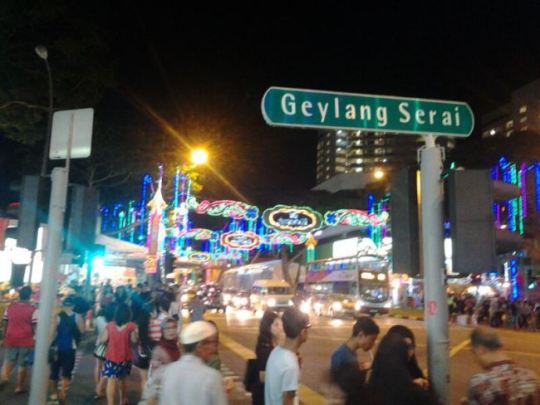
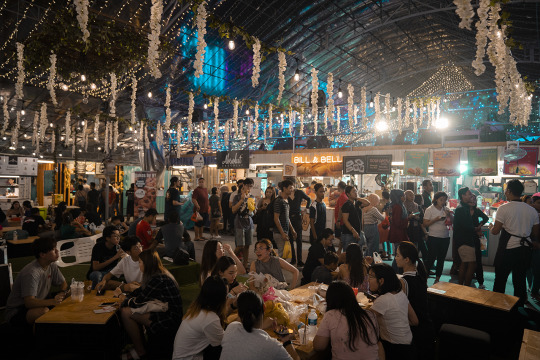
In Geylang too, they will buy traditional clothes to visit family. Baju kurung (ehh for traditional clothes, women wear baju kurung, men wear baju melayu but the names are the same anyway) is the normal clothing. Often, one household will choose to coordinate colors together (but it's not mandatory, lmao my family doesn't care)
For men, they wear songkok (that flat black hat) and samping (the long scarf wrapping around the waist)
For women, wear a sarong (skirt) with a long top. If desired, will also wear a tudung (type of hijab) (i should also clarify for muslim women its their choice whether they want to habitually wear hijab. its not just specific to just baju kurung. for example i have lots of aunties that dont wear hijab at all meanwhile i have a lot of aunts who do)
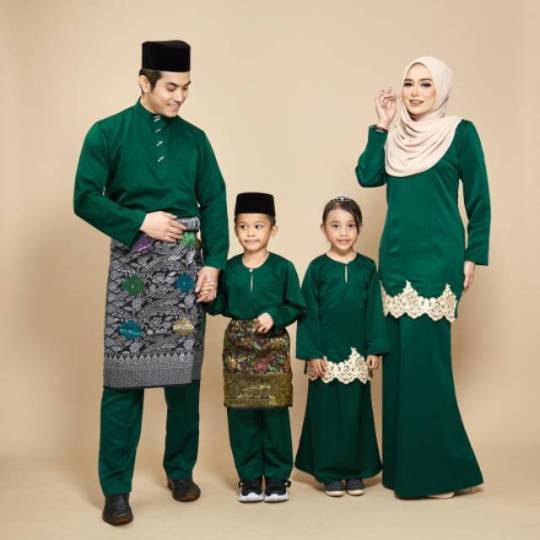
Baju kurung is also worn at other festivities, such as weddings

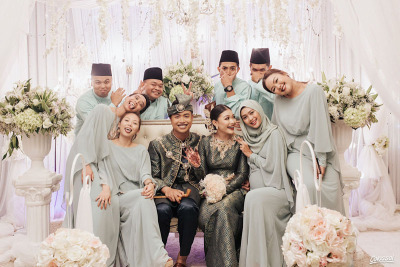
(my whole childhood I attended so many weddings, this is another topic lmaooooo)
On Hari Raya Aidifilti but before going to raya (this is what we generally call going out to see family), close family in will ask for forgiveness. (it's important the forgiveness is not one-sided, the adults will also ask forgiveness from the younger family members too). Usually this is when people start crying. After that, we go RAYA!!! When in someone else's house, if you are not working now, you can get duit raya! (because I grew up in singapore surrounded by chinese influence, I also call this "angpao" too)
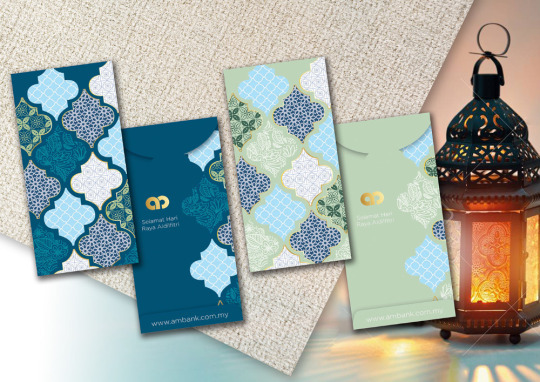
OHHHH THERE IS A LOT OF FOOD;;;; My grandmother would cook a lot during Ramadan and Hari Raya. Rendang, lontong, KETUPAT OHHH KETUPAT, CHICKEN CURRY (my mother every aidifitri cooks green chicken curry, FOR HARI RAYA AIDIFITRI ONLY, ohhhhh that's my favorite part, ASBFKASB I'M HUNGRY.)
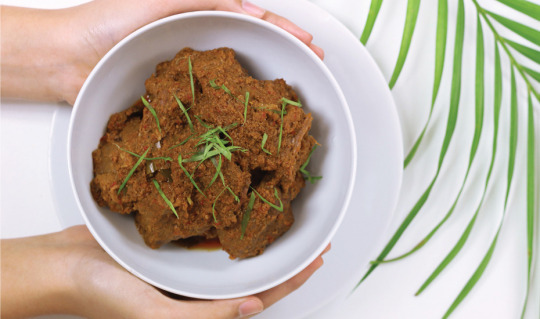
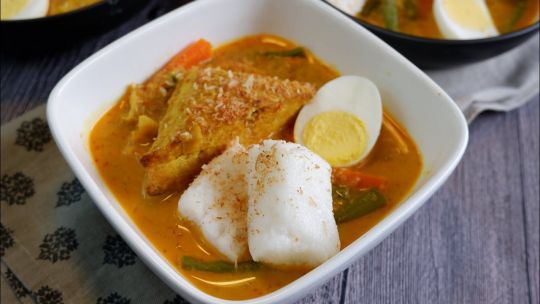
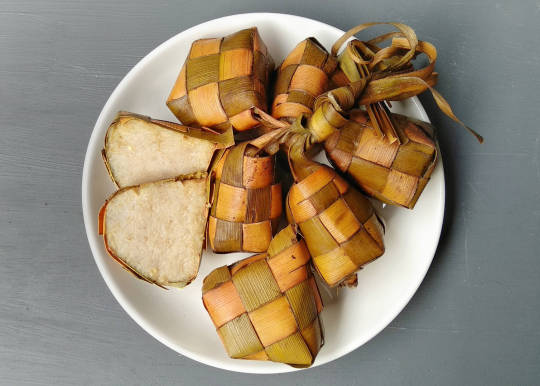
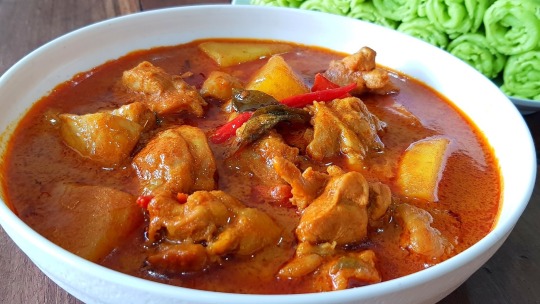
(theres also like way more cuisine than this, iu havent even mentioned nasi goreng and nasi lemak and briyani and FUCKIGN BEGEDIL;;;;)
ketupat is kind of icon to represent Aidifilti holiday, for example:
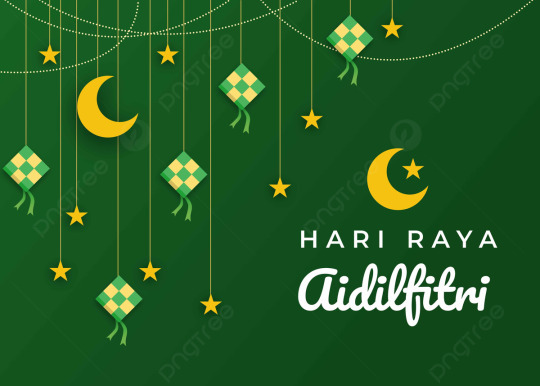
other icons of hari raya include: bunga api, neon string lights, bamboo torches, etc.
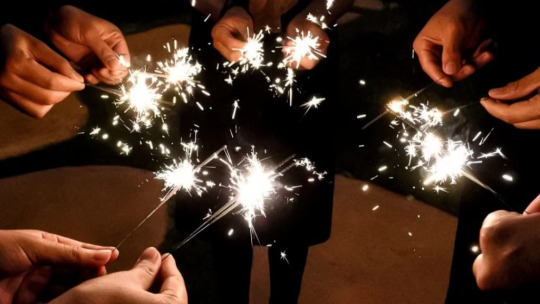
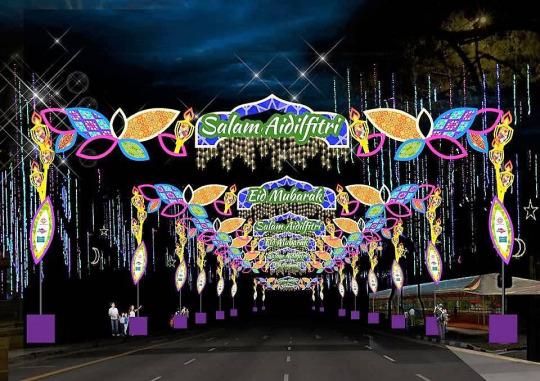

I love Hari Raya even thoug my feet hurt ALOT after visiting LOTS OF FAMILY AND FRIENDS OH MY GOD:;; it's okay if you take your shoes off in the house somehow your FEET WILL HURT at the end of the day;;;;;;
uhhhh others about malay culture? we have art! A martial art is silat melayu! I don't know much about this but it's great

there is performance art: one example is dikir barat
youtube
juga ada permainan, ada yang terkenal ialah wau (kite)

and congkak (like that one club penguin game, mancala, im not kidding)
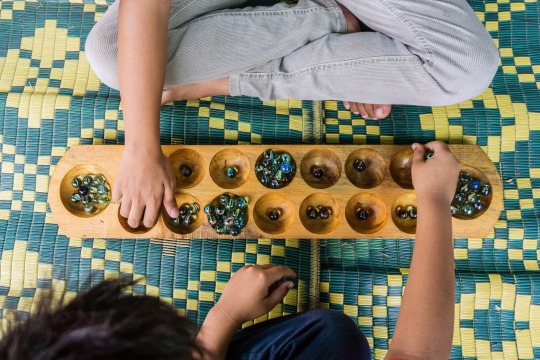

there are many malay cultures that are also from indonesian culture because of its influence. (Mainly malay culture was influenced by its neighboring cultures such as from Thailand, Sumatra, Java. Malay culture were from Hinduism before then converting to Islam) That's why we have wayang kulit (natively from Java)
(a lot of indonesian culture and malay cultures share similar things because of kinda their similar roots and their spread of their own culture, hence why we also have similar dishes, traditonal clothes, even our language is kinda 70% the same)

Do you know; Singapore was discovered by Sang Nila Utama and was originally Malay kingdom (at that time the island was called Temasek before it was owned by the British) (the original indigenous of Singapore are called Orang Laut, litterally translated to "people of the sea"). That is why in Singapore, the language and the national anthem (Majulah Singapura) is in Malay. Singapore is not only for Chinese people, we Malays and Indians are also here;;;
(and im not at all from malaysia god please none of my relatives are. Malaysian is referring to the country, Malay is the language and the ethnic group)
There's a whole lot more I haven't even touched on, like lmao there's a whole thing about weddings and a whole baby shower thing.
theres also a lot of singaporean stuff i want to share i haven't even mentioned singlish but thats a post for another time
55 notes
·
View notes
Text
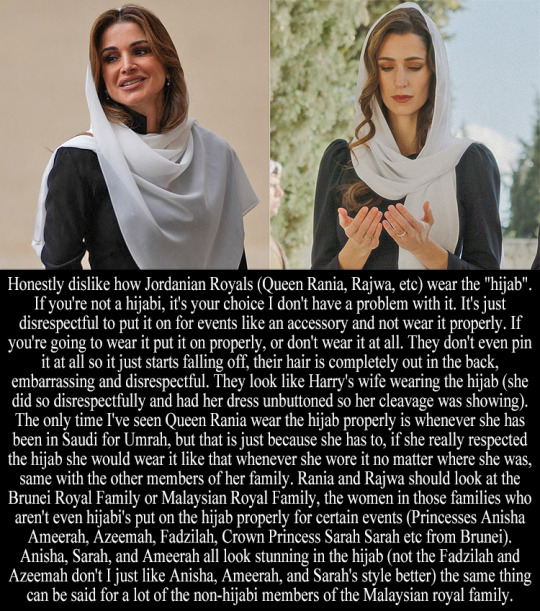
“Honestly dislike how Jordanian Royals (Queen Rania, Rajwa, etc) wear the "hijab". If you're not a hijabi, it's your choice I don't have a problem with it. It's just disrespectful to put it on for events like an accessory and not wear it properly. If you're going to wear it put it on properly, or don't wear it at all. They don't even pin it at all so it just starts falling off, their hair is completely out in the back, embarrassing and disrespectful. They look like Harry's wife wearing the hijab (she did so disrespectfully and had her dress unbuttoned so her cleavage was showing). The only time I've seen Queen Rania wear the hijab properly is whenever she has been in Saudi for Umrah, but that is just because she has to, if she really respected the hijab she would wear it like that whenever she wore it no matter where she was, same with the other members of her family. Rania and Rajwa should look at the Brunei Royal Family or Malaysian Royal Family, the women in those families who aren't even hijabi's put on the hijab properly for certain events (Princesses Anisha Ameerah, Azeemah, Fadzilah, Crown Princess Sarah Sarah etc from Brunei). Anisha, Sarah, and Ameerah all look stunning in the hijab (not the Fadzilah and Azeemah don't I just like Anisha, Ameerah, and Sarah's style better) the same thing can be said for a lot of the non-hijabi members of the Malaysian royal family.” - Submitted by kaurisato
“In Islam, women visiting graves was a bit frowned upon because some women wouldn't dress appropriately or would make a show of glamour and fashion there, and I feel like the jrf women did exactly that. Don't get me wrong they were pretty good dresses but the lengths were not appropriate islamically for such an occasion at all. And don't get me started on their hijabs. The jrf women could really learn from the brunei rfs women like anisha who aren't hijabis but put it on properly for engagements.” - Submitted by Anonymous
23 notes
·
View notes
Text

Borneo is the largest island in Asia, with a rich history and diverse ethnic groups such as Dayak, Malay, Bajau, Kedayan, Banjar, Kadazandusun and many more.
Borneo, a land blessed with wildlife and unparalleled natural beauty as well as abundant natural resources.
At an estimated 130 million years old, Borneo's rainforest is two times as old as the Amazon rainforest in South America.
Evidence for prehistoric human occupation of Borneo has been found at Neah Cave in Sarawak, including fossil bones, stone tools, and wall and ceiling paintings. Borneo is first mentioned in Ptolemy’s Guide to Geography of about 150 CE. Roman trade beads and Indo-Javanese artifacts have been discovered that give evidence of a flourishing civilization dating to the 2nd or 3rd century CE. Three rough foundation stones with an inscription recording a gift to a Brahman priest dated from the early 5th century, found at Kutai, provide evidence of a Hindu kingdom in eastern Kalimantan. Brahmanic and Buddhist images in the Gupta style have been found in the valleys of the Kapuas and other rivers in western Kalimantan. Later Kalimantan rulers were probably feudatories of the Majapahit empire of eastern Java (c. 1293–1520). With the arrival of Islam early in the 16th century, a number of Muslim kingdoms were founded, including the Banjarmasin, Sambas, Sukadana, and Landak. The Sukadana rulers owed allegiance to the Muslim Mataram kingdom of Java.
Modern European knowledge of Borneo dates from travelers who passed through Southeast Asia in the 14th century. The first recorded European visitor was the Franciscan friar Odoric of Pordenone, who visited Talamasim on his way from India to China in 1330. The Portuguese, followed by the Spanish, established trading relations on the island early in the 16th century. At the beginning of the 17th century the Portuguese and Spanish trade monopoly was broken by the Dutch, who, intervening in the affairs of the Muslim kingdoms, succeeded in replacing Mataram influence with their own. The coastal strip along the South China and Sulu seas was long oriented toward the Philippines to the northeast and was often raided by Sulu pirates. British interests, particularly in the north and west, diminished that of the Dutch. The Brunei sultanate was an Islamic kingdom that at one time had controlled the whole island but by the 19th century ruled only in the north and northwest. In 1841 Sarawak was split away on the southwest, becoming an independent kingdom ruled by the Brooke Raj. North Borneo (later Sabah) to the northeast was obtained by a British company to promote trade and suppress piracy, but it was not demarcated until 1912. Those losses left a much-reduced Brunei, which became a British protectorate in 1888.
During World War II the Japanese invasions of Borneo (1941–42) quickly eliminated the token British and Dutch forces on the island, which was not retaken until 1945. In July 1946 both Sarawak and North Borneo were made British crown colonies. In Dutch Borneo a strong nationalist sentiment developed and led to fighting between Indonesian and Dutch forces as the latter attempted to reimpose Netherlands control. Sovereignty passed to the Indonesians in 1949, and in 1950 a new constitution proclaimed Dutch Borneo part of the Republic of Indonesia.
The British government relinquished its sovereignty over Sabah and Sarawak in 1963, when those territories joined the Malaysian federation. That marked the commencement of Indonesian hostilities in the form of guerrilla raids across the border. Those raids ceased by agreement in 1966. Except for the period of Japanese occupation, Brunei remained a British protectorate until 1983. It became fully independent on January 1, 1984.
BORNEO, 1 Island, 3 Countries
6 notes
·
View notes
Text
who: @rhea-florent
where: casino night
notable deets: after allun florent and alysa corbray divorce, allun has a daughter named rhea. while the siblings aren't as close as most siblings at the school, going to a boarding school together allowed them to get to know one another. maintaining contact over the years.
Omer developed a love for gambling when he was in Brunei, spending nights with the others gambling between missions or assignments. And while it was different to gamble with dice, Omer learned to count cards when gambling in the different bars and cafe's around the different villages he visited in Asia. As he downed another drink, he placed a cigarette between his lips and stepped outside to stand on the otherside of the door.
As he stepped outside, he stopped briefly to reach out and shake the hand of a man walking by, sharing a brief conversation with them before they went in and he was fishing the lighter out of his pocket.

"Oy, Rhea. C'mere you." Omer hadn't see his sister in some time and while they were different in many ways, he was always glad to see her.
5 notes
·
View notes
Text
2024/49 “Minorities in Brunei Darussalam: Intersecting Religion and Ethnicity” by Chang-Yau Hoon and Asiyah Kumpoh
EXECUTIVE SUMMARY
This Perspective offers a nuanced understanding of the interplay between religion and ethnicity among minority groups in Brunei Darussalam, a nation where Islam constitutes the majority religion and where religious proselytisation, except for Islam, is strictly forbidden.
The discussion focuses on two minority groups within the nation: the Christians and the ethnic Dusuns who uphold traditional faiths.
An examination of the two groups reveals that the Christian community maintains mutual respect and understanding, fostering peaceful coexistence with the dominant religion, while the Dusuns’ experience highlights the mutual tolerance between the community and the state. In effect, the Dusuns are given considerable autonomy to manage their religious matters and engage in ethnic rituals without apparent interference from the state.
This Perspective also delves into the interconnectedness of faith practices and ethnic culture, which often results in certain ethnic ceremonies, like Adau Gayoh, being publicly celebrated in communal spaces.
By examining how religion and ethnicity intersect and how religious minorities negotiate their space to practise their religions in Muslim-majority Brunei, this Perspective unveils the agency of religious minorities in navigating state-society relations.
*Chang-Yau Hoon is Professor of Anthropology at the Institute of Asian Studies, Universiti Brunei Darussalam (UBD), and Visiting Senior Fellow at ISEAS – Yusof Ishak Institute. He was formerly Director of Centre for Advanced Research, UBD. Asiyah Kumpoh is Senior Assistant Professor at the Faculty of Arts and Social Sciences (FASS), Universiti Brunei Darussalam and Director of Institute for Leadership, Innovation and Advancement, UBD. She was formerly Dean of FASS at UBD.
ISEAS Perspective 2024/49, 5 July 2024
Download pdf
6 notes
·
View notes
Text
the other day i was thinking about how i would want to travel the world when i have money of my own but that long flights sound like a nightmare (my longest flight ever was like 3 hours i think) so i came up with this fun game in which i looked up how much it would take me to circumnavigate the world using exlusively short flights.
so, that's what i did. first of all, rules and disclaimers:
-all flights have to be around 3 hours long (so no longer than 4 hours).
-they also have to be direct flights
-i more or less counted travel time between connections to make it as realistic as possible, tho with the final schedule i would barely get some rest and it would be cool to visit some of the cities i'd fly to so in an ideal world where this would be feasable, i'd make it longer and with more time to sleep and do tourism i think.
-despite trying to follow everything, unfortunately i didn't take into account how freaking large oceans are, so the flights in the pacific and the atlantic will unfortunately be over 4 hours long. i tried looking for the shortest flights tho, so they're not ridiculously long either.
anyways, the schedule i would follow is below the cut:
in total, i would have to take 18 planes in 10 days:
madrid (MAD) - athens (ATH): 3 hours 25 minutes, Aegean Airlines, 12:40-17:05.
athens (ATH) - tbilisi (TBS): 2 hours 40 minutes, Aegean Airlines, 00:10-03:50.
tbilisi (TBS) - almaty (ALA): 3 hours 35 minutes, Air Astana, 22:20-02:55.
almaty (ALA) - delhi (DEL): 3 hours 25 minutes, Air Astana, 10:05-14:00.
delhi (DEL) - dhaka (DAC): 2 hours 25 minutes, Air India, 17:05-20:00.
dhaka (DAC) - kuala lumpur (KUL): 3 hours 55 minutes, Batik Air Malaysia, 23:00-04:55
kuala lumpur (KUL) - brunei (BWN): 2 hours 30 minutes, Royal Brunei, 12:10-14:35
brunei (BWN) - manila (MNL): 2 hours 15 minutes, Royal Brunei, 11:55 - 14:10
manila (MNL) - guam (GUM): 3 hours 55 minutes, United Airlines, 22:25-04:20
guam (GUM) - pohnpei (PNI): 2 hours 30 minutes, United Airlines, 20:25-23:55
pohnpei (PNI) - majuro (MAJ): 2 hours 10 minutes, United Airlines, 15:20-18:30
majuro (MAJ) - honolulu (HNL): 4 hours 40 minutes, United Airlines, 19:30-02:10
honolulu (HNL) - san francisco (SFO): 5 hours 01 minutes, United Airlines, 07:00-15:01
san francisco (SFO) - dallas (DFW): 3 hours 35 minutes, American Airlines, 17:00-22:35
dallas (DFW) - new york city (LGA): 3 hours 35 minutes, Spirit Airlines, 05:33-10:08
new york city (JFK) - reykjavik (KEF): 5 hours 35 minutes, Iceland Air, 13:00-22:35
reykjavik (KEF) - paris (CDG): 3 hours 25 minutes, Iceland Air, 00:45-06:10
paris (CDG) - madrid (MAD): 2 hours 10 minutes, Iberia, 12:40-14:50
#it's such a pain to get out of the pacific everything is too spread out#also i did a fuckup when i was planning the route so for a while i had to look up a new route#basically everything between athens and guam. so a lot of it sjdjsdjs#might as well tell you which was my original route cause it's quite different#for some reason i thought the flight to riyadh from athens was less than 4 hours long (it's not) so i had planned athens to riyadh#followed by riyadh - karachi. karachi - islamabad. islamabad - ürümqi. ürümqi - beijing. beijing - tokyo. and ofc tokyo - guam#so pretty different#i wouldn't had even touched southeast asia
6 notes
·
View notes
Text
i love being southeast asian.
despite whatever unhappy history, despite the rise of ethnonationalism and racism in our countries; despite the fact that most of us remain in the global south under the invisible thumb of western empires and conglomerates, exploited by rich expats and beg-packers; despite the conservatism, the bigotry, the pain and prejudice and the corruption.
despite all that, i love where i am from. this is my home.
my hands tenderly trace the lines of our history and find within it a colourful collection of influences that continue to shape us until today:
the native malays, javanese, sundanese, minangkabau, bugis, visayan, tagalog, and other dominant peoples.
alongside indigenous tribes like the iban, kadazan, sama-bajau, temuan, penan, jakun, and hundreds upon hundreds more ethnic groups.
all of us holding onto our ancestors' mysticism and spirituality and animism, the watchful gaze of legacy fixed on us as we move through an ever-changing and modernising world (and what is modernity anyway? isn't civilisation overrated?).
and then the chinese peoples. the hainanese, hokkien and cantonese and more, many of whom came here due to trade in the pre-colonial era, but then most arrived as the imported labour for the colonial powers.
but this is their home too. we live here together, and through them we all celebrate lunar new year and the mid-autumn festival. all of us give red envelopes during our many festivals. we give oranges that symbolise prosperity and ring in the year of the rabbit, dragon, snake, horse, goat. we hold lion dance performances in our malls and marks. we eat and exchange mooncakes.
and then the indian peoples, though mostly tamil indians from south india, but also sikhs, malayalis, and punjabis, who arrived and assimilated and spread their culture and beliefs much earlier before the pre-colonial era, causing the indianisation of southeast asia. then more indian peoples came during the colonial era, again, as imported labour, working our fields or donning the uniform of our common oppressors, kept walled away from us despite how alike we look and sound.
because truly we do sound the same. sanskrit remains an abundant source for a large chunk of our languages. i hear the vedic mantras and can pick apart words that sound familiar. hinduism and buddhism still leaves its traces in our cultures even for those of us who've shifted to islam.
and yes, islam. we're not what the west thinks of when they talk about the muslim world, but southeast asia has some of the largest muslim populations in the world. because through trade, since the medieval times, islam came here and with it brought so many arabic influences that has come to shape our languages and customs, with plenty of our cultures having since been morphed around islamic beliefs and ideas. in malaysia and indonesia and brunei (and perhaps even certain parts of the philippines) you'll find a mosque or a prayer room everywhere you go. and every ramadan millions of us fast, every eid all of us dress up and visit each other's houses for feasts and festivities.
then of course came european colonisation at the hands of the portugese, dutch, british (in malaysia and indonesia's case we got all three), spanish, and french their reigns lasting over 400 years. and from them we came european culture and more new languages, english quickly becoming a second language (or even a first language) for so many of us, missionaries building churches and spreading the word of jesus christ as the son of god; with their fair features they draw a line between us and them, between the civilised and the barbarians, between the light-haired light-eyed and the unruly dark-haired dark-eyed.
and then comes world war 2 and the japanese invasion, and for most it was so brutal and violent, and for the rest it was miserable, with famine and inflation but we were forced to sing songs in japanese anyway, to watch their planes fly in the sky towards their enemies, to swallow their ideas in our parched throats.
and then the war ended and wounds began to heal, and then came the 1980s until now with all its shiny technology: nintendo, panasonic, television and anime, and now we have leagues of people learning japanese language and culture anyway, except now it is done wholeheartedly, and as it turns out japanese isn't even that different from our own cultures anyway. houses on stilts made of wood with thatch roofs, making our living from the sea and coast, eating rice for every meal, our phonetics and theirs so alike.
and today we have waves of their expats migrating here because of course they do, we're the Global South™ and for them it's cheap and affordable, so we have little japans sprouting here and there and sometimes i go to a random street and find signs written in japanese and read bits of broken hiragana.
and it's beautiful, being able to move through this world and find the handprints we've all left upon it. it's a wonderful amalgam of so many traditions and colours and beliefs and language all mixing around in this huge bubbling melting pot.
and i'm not chinese or indian or arab or british but when i see them on tv, i'm also seeing a part of me, i hear the words in their tongue and i recognise them as mine, i eat their food and know them as intimately as my own.
but of course our politicians, our kings and our prime ministers (and the divide-and-conquer rule of colonisers now gone) continue to divide us and make us hate each other, fanning flames of distrust and fear of that-which-is-different.
it's such a shame too, because it's so special. it's what makes us us, our dozens of creoles, the way we can speak a sentence comprising vernacular from at least four languages and we all understand each other anyway.
we have a word in malay, "rojak", which is also the name of a dish that mixes a bunch of different ingredients, and is found in malaysian, indonesian and singaporean cuisine. but where i'm from, we also say "rojak" to mean anything that's an eclectic mixture of things, things that seemingly don't go together and aren't necessarily pleasing to the eye but still, somehow, it works, in fact it tastes good, spicy and flavourful and hearty.
and that's us: southeast asia, all of it, a beautiful rojak culture. and it's ours.
#writeblr#people of color#writers on tumblr#writers of color#writing#southeast asia#asian culture#i woke up today and started feeling so many things. i looked around and felt full of love.#but i go on social media and it makes me angry and sad to see how much everyone hates each other#my love is not for what it is but what it could be#lots of my friends wish they could leave. emigrate to australia or UK or US. but even if i could i wouldn't.#this is my home. there is nowhere else.#when i was teaching and i saw those kids' faces it cemented it for me even more.#like if not for anything else i'll stay. i'll do it for them. carve out a community for them. for us.#shut up haydar#scribblings.txt
12 notes
·
View notes
Text
By: Richard Dawkins
Published: Mar 22, 2024
I want to make a three-way distinction. You can be a Cultural Christian, a Political Christian, a Believing Christian, or any combination of the three. People may disagree about which of these constitutes being “A Christian”. For me it has to be Believing Chistian.
I am a Cultural Christian, specifically a Cultural Anglican. I was educated in Christian schools. The history of my people is heavily influenced by Christian tradition. I like singing Christmas Carols, and am deeply moved by the sacred music of Bach and Handel. My head is full of Biblical phrases and quotations. And hymn tunes, which I regularly play by ear on my electronic clarinet.
I think Ayaan Hirsi-Ali (who is one of my favourite people in the world) is a Political Christian. She was brought up in the culture of Islam and is well aware of the horrors that that religion is still visiting on Muslims around the world, especially women. She sees Christianity as a relatively benign competitor, worth supporting as a bulwark against Islam. Just as most of us support a political party without agreeing with all its policies, because we prefer it to the alternative, a Political Christian may support Christianity without being a Believing Christian, because it’s better than the main alternative. Ayaan is a Cultural Muslim, and it is this that has driven her to be a Political Christian.
Believing Christians believe that there is a supernatural creator at the base of the universe called God. They believe a First Century Jew called Jesus is the son of God. They believe Jesus’s mother was a virgin when she gave birth to him. They believe that Jesus came alive again three days after he died. They believe that we ourselves have an immortal soul which survives our bodily death. They believe that God listens to our prayers. I strongly suspect hat Ayaan doesn’t believe any of these things. She is not a Believing Christian.
In my language, that means she is not a Christian at all. Others may include Cultural Christian in their definition of Christian, in which case I am a Christian. Indeed, Ayaan herself is reported to have called me one of the most Christian people she knows. But by the same token, the implication would be that she is a Muslim because she is a Cultural Muslim. And she certainly would not call herself a Muslim.
So, Ayaan is a Political Christian but she is no more a Believing Christian than I am. Her example leads me to consider my own position. Am I a Political Christian? I am in no doubt that Christianity is morally superior to Islam. Just look at the regions of the world with an explicitly Islamic government, or where Islam is the dominant political influence: Iran, Afghanistan, Pakistan, Indonesia, Somalia, Northern Nigeria, Brunei, Turkey (betraying the admirable secularism of its post-Ottoman foundation) Saudi Arabia and many other countries of the Arab world. Laws vary, but recurrent patterns include mistreatment of women as second class citizens, persecution of gays, forced marriage, violent intolerance of what is considered blasphemous, anti-Jewish prejudice going so far as to laud Hitler, draconian punishment for apostasy, and for adultery which is often deemed to include simply talking to a member of the opposite sex other than a spouse or relative. Christianity has its bad points, and in earlier centuries it has been as bad as Islam. But today there’s no contest. When it comes to evil, Islam wins hands down, by a huge margin. No other religion comes close.
If I were American I would vote Democrat because, in spite of their idiotic stance on the male/female distinction, they are hugely preferable to the Republican alternative. Similarly, if I were forced to vote for either Christianity or Islam as alternative influences on the world, I would unhesitatingly vote Christian. If that make me a Political Christian, so be it. I am perhaps as much of a Political Christian as Ayaan is. But does that make either of us a Christian?
In my language, certainly not. For me, as a scientist, truth or falsehood of beliefs is what really defines a word like Christian or Muslim. If you are going to call somebody a Christian without qualification, I think it’s a confusion of language to mean anything less than a Believing Christian. You are at liberty to dissent from that definition. But let us at least be clear what definition we are using. If Ayaan says she’s a Christian and I say she’s not, we are really not disagreeing. We are defining our terms differently. She uses “Christian” to include “Political Christian” for herself and “Cultural Christian” for me. I don’t think you can be a real Christian if you don’t believe the fundmental tenets of Christianity.
The only disagreement is a semantic one. I am a Cultural Christian but not a Believing Christian, which, in my language means I am not a Christian. You, Ayaan, are a Political Christian, which in your language, but not mine, makes you a Christian. But we are neither of us Believing Christian. And this, in my language but not yours, makes neither of us Christians. So, dear Ayaan, let’s not agree to differ. Let’s agree that we don’t really differ.
Dissident Dialogues
I’m happy to say I’ll be having a public conversation with Ayaan Hirsi-Ali at the inaugural Dissident Dialogues. Obviously her announcement that she has become Christian will be a major part of the discussion. The conference will be in New York, May 3rd & 4th. Distinguished speakers include Steven Pinker, John McWhorter, Kathleen Stock, Alex O’Connor, and many other leading thinkers.
#Richard Dawkins#Ayaan Hirsi Ali#christianity#islam#political christianity#cultural christianity#believing christianity#religion#supernatural#religion is a mental illness
6 notes
·
View notes
Text

Neon in Kebaya to visit me and @thelovelyghostwriter in her trip to Southeast Asia (Indonesia, Singapore, Malaysia
The version of kebaya Neon is wearing is my favorite type (Kutubaru Kebaya), I always wear this type to semi-formal events.
Kebaya is officially recognised as the national attire of Indonesia,[10][15] and its fashion icon,[16] although it is more popularly worn by Javanese, Sundanese and Balinese people. In Malaysia, Singapore and Brunei, it is recognized as one of its ethnic attires especially among Malay and Peranakan communities;[n 3] the complete outfit is known in these region as "sarong kebaya".[6] The style of sarong kebaya vary from place to place throughout the region.
14 notes
·
View notes
Note
I’m pre-angry! 😡 You are all correct, the PR team acts like they hate Rajwa. After months of silence, Why is their first official visit to Singapore which is so conveniently close to Brunei a and why are they traveling there only three days before the big, lavish bash to celebrate Mateen? Even if we don’t see them at the wedding, of course they will be attending…
If we do see her at the trip and wedding: Couldn’t they give her something to do in Jordan or in favor of Palestine BEFORE putting her in a flight to far Asia?
What’s going on with the Jordanian royal family, so disappointing and it will be even more disappointing if she is really pregnant and this is their way to show it.
Yes this is so true!
They did her dirty. And even if they don't actually attend the wedding (or they secretly attend it) people will still be convinced that they went there just for the party. I think she's pregnant guys hhhh and I can't wait to see if this is true.
7 notes
·
View notes